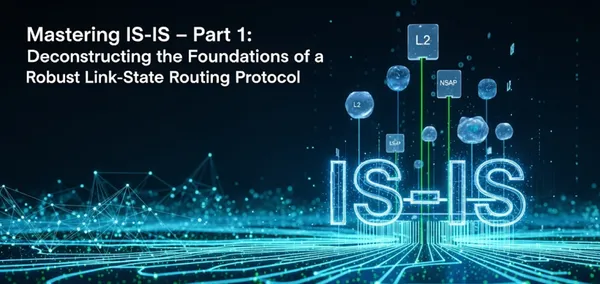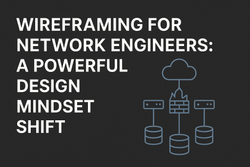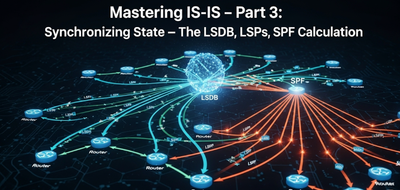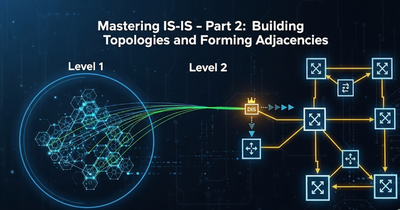On this page
In the crowded arena of dynamic routing protocols, IS-IS (Intermediate System to Intermediate System) often flies under the radar, especially in enterprise environments dominated by OSPF and BGP. However, for engineers architecting, deploying, and maintaining scalable, stable, and high-performance networks—particularly within the demanding landscapes of service providers, large-scale data centers, and critical infrastructure—IS-IS offers an unparalleled blend of elegant simplicity, inherent robustness, and remarkable scalability that makes it the preferred choice for many core infrastructures.
In this foundational first installment of the Mastering IS-IS series, we will embark on a comprehensive deconstruction of IS-IS, delving into its historical origins, dissecting its unique terminology, unraveling its architectural prowess, and articulating precisely why it remains a quintessential protocol in high-scale link-state routing designs. Beyond theoretical exposition, this post will ground concepts in practical application by exploring IS-IS's fundamental Layer 2 operational model and the critical role of NSAP addressing, complete with specific Juniper CLI configuration examples to bridge the gap between theory and real-world deployment.
Origins and Architectural Paradigm: Why IS-IS Still Matters in the IP-Centric World
IS-IS's genesis is rooted in the ISO CLNS (Connectionless Network Service) protocol suite, designed to provide a routed infrastructure for non-IP networks. Its adaptation to support IP came via the IETF's Integrated IS-IS specification (RFC 1195), a pivotal moment that preserved the protocol's inherent strengths while extending its reach to the dominant IP landscape. This adaptation wasn't merely a retrofit; it showcased IS-IS's remarkable adaptability and forward-thinking design, cementing its relevance even decades later.
Key Architectural Differentiators:
- Native Layer 2 Operation (OSI Data Link Layer): Unlike OSPF, which operates at Layer 3 (IP) and uses IP multicast for neighbor discovery and LSA exchange, IS-IS fundamentally operates directly over the data link layer (Layer 2). This means IS-IS PDUs are encapsulated directly within Layer 2 frames (e.g., Ethernet, PPP, HDLC) without requiring an IP header. This unique characteristic grants IS-IS a profound resilience; it can continue to converge and route even if the IP control plane is experiencing issues, making it less susceptible to certain types of IP-based attacks or misconfigurations in the underlay. The protocol discovers neighbors and exchanges routing information using its own dedicated Layer 2 protocol identifier.
- Type-Length-Value (TLV) Structure for Extensibility: The architectural elegance of IS-IS lies significantly in its pervasive use of Type-Length-Value (TLV) fields for encoding all protocol messages. Every piece of information within an IS-IS PDU—from neighbor hellos to link-state advertisements (LSPs) and even network reachability information—is encapsulated within a TLV. This modular, self-describing structure provides unparalleled extensibility. New capabilities, such as MPLS Traffic Engineering (TE), IPv6 routing, Segment Routing (SR-MPLS), and even emerging technologies like SRv6 or BIER (Bit Index Explicit Replication), can be seamlessly integrated into IS-IS simply by defining new TLVs without requiring fundamental changes to the protocol's core operation. This forward-compatibility is a major reason why IS-IS comfortably underpins modern, complex network services.
- Robust Link-State Database (LSDB) Flooding Model: Like OSPF, IS-IS employs a link-state routing paradigm. Routers build a comprehensive topology map of the network, known as the Link State Database (LSDB), by reliably flooding Link State PDUs (LSPs) throughout their respective areas. Each LSP describes a router's direct connections, the state of those connections, and the prefixes it originates. The LSDB enables each router to independently compute the shortest path to all destinations using Dijkstra's Shortest Path First (SPF) algorithm, thereby ensuring loop-free paths by design and rapid convergence in response to topology changes.








